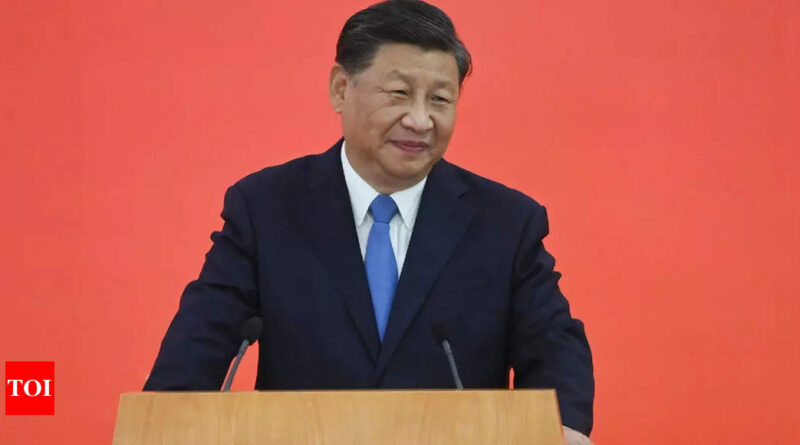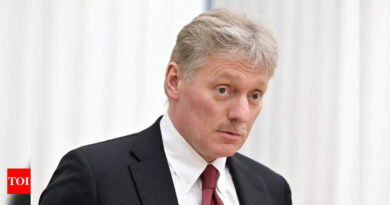China revamps overseas lending as US narrows spending gap – Times of India
China is overhauling the way it lends to developing nations, a strategy that may help their largest official creditor maintain a narrowing lead over the US and its Group of Seven allies.
Beijing has begun moving away from the big bilateral deals it was eager to strike a decade ago — when it first launched its flagship Belt and Road Initiative that mainly lends to infrastructure projects — in favor of collaborative lending that reduces its exposure to financial risk, according to a new report published by AidData at William and Mary, a public university in Virginia.
The result is a moderate pullback in spending, though China still beats G7 countries. The Asian nation in 2021 provided aid and loans worth $79 billion to low- and middle-income nations, more than the $61 billion provided by the US, according to the latest available data from AidData. The World Bank that year made commitments worth around $53 billion.
Compare that to the period between 2013 and 2017, when Beijing averaged around $117 billion each year in financing to developing countries — an amount that outpaced Washington’s spending nearly three-to-one, the report said. That’s a lot higher than previously thought.
A lot has changed in the decade since President Xi Jinping launched Belt and Road. As several recipients of its funding declare sovereign default, Beijing has faced accusations of being an irresponsible lender. Xi’s close diplomatic relationship with Russian President Vladimir Putin and geopolitical tensions with the West have added to strains, contributing to waning interest from Europe in the Belt and Road program.
Those issues — coupled with an economic slowdown at home — may be forcing China to rethink its approach to lending as it seeks to maintain its financial influence within the developing world.
“China is not going to stand by and watch its flagship global infrastructure initiative crash and burn. That’s just not going to happen,” said Brad Parks, the executive director of AidData and lead author of the report. “Beijing is effectively on a rescue mission. It is kind of scanning its global portfolio and it’s firefighting in response to crises.”
Cautious approach
China’s more cautious approach comes down in part to the financial problems faced by many of the countries that borrowed from the world’s second-largest economy.
Around 80% of Beijing’s lending to the developing world goes to supporting nation in financial distress, according to AidData. The researcher’s database covers some $1.34 trillion in financial instruments across 165 countries from 2000 to 2021. That includes some projects committed to in that time frame that may not have been started until this year.
Parks pointed to some recalculations that suggest a change to China’s view in the long term, for which it has set up new loan and project safeguards. The country has started to outsource its risk analysis to international institutions like the International Finance Corporation, the World Bank’s private sector arm. It’s also investing via syndicated loans led by western commercial banks.
That’s made China a far more efficient lender and investor in projects in the developing world, according to AidData. While it’s using western institutions to make that happen, most of the projects the country is investing in are still being built by Chinese contractors.
The report also noted a shift in the structure of deals Beijing is pursuing. Half of China’s non-emergency lending portfolio in low- and middle-income countries is now provided via syndicated loan arrangements. More than 80% of those involve Western commercial banks and multilateral institutions, according to AidData.
“Beijing is behaving like a yield-maximizing investment portfolio manager,” Parks and the other authors of the report wrote, adding that the country’s efforts to derisk have been “poorly understood” by policymakers in Western capitals. “Washington, London, and Brussels increasingly run the risk of competing with a version of the BRI that no longer exists.”
Risks remain
A recalibration of its approach to lending doesn’t protect Beijing from reputational risks. The US and Europe have grown increasingly wary of China’s influence in recent years, resulting in efforts to curtail Beijing’s ambitions on everything from technology to electric vehicles.
Rising geopolitical stress has spurred some countries to reconsider whether working with China on Belt and Road or other programs is worth the effort. Italy, the sole G7 member to join China’s flagship initiative, is set to exit the program by the end of the year. The Philippines said last month it would no longer pursue Chinese funding for three railway projects amid tensions in the South China Sea.
Beijing’s public approval rating in the developing world plunged from 56% in 2019 to 40% in 2021, the AidData report said, citing Gallup World Poll data.
Describing Chinese lending “as a debt trap is just smears,” Chinese foreign ministry spokesman Wang Wenbin said during a regular briefing in Beijing on Tuesday in response to a question on the AidData report. “China will appear in countries and at a time when Western, developed countries would not like to appear,” he added.
Despite challenges, China may still be able to hang onto its lead as a lender to the developing world as it refines its new strategy, according to Parks. He also stressed one crucial advantage the West has yet to match: Beijing is much faster at delivering projects.
“Speed is everything” for leaders of developing nations who want to build infrastructure said Parks, adding that Western development banks can take more than a decade to deliver projects that China’s capable of in three years. He and the other researchers added that Washington faces difficulty competing “dollar-for-dollar” with Beijing, meaning they must carefully select the places that will give them the greatest return.
“Unless or until the G7 addresses that issue frontally,” Parks said, “they’re going to be at a comparative disadvantage vis-a-vis Beijing.”
Beijing has begun moving away from the big bilateral deals it was eager to strike a decade ago — when it first launched its flagship Belt and Road Initiative that mainly lends to infrastructure projects — in favor of collaborative lending that reduces its exposure to financial risk, according to a new report published by AidData at William and Mary, a public university in Virginia.
The result is a moderate pullback in spending, though China still beats G7 countries. The Asian nation in 2021 provided aid and loans worth $79 billion to low- and middle-income nations, more than the $61 billion provided by the US, according to the latest available data from AidData. The World Bank that year made commitments worth around $53 billion.
Compare that to the period between 2013 and 2017, when Beijing averaged around $117 billion each year in financing to developing countries — an amount that outpaced Washington’s spending nearly three-to-one, the report said. That’s a lot higher than previously thought.
A lot has changed in the decade since President Xi Jinping launched Belt and Road. As several recipients of its funding declare sovereign default, Beijing has faced accusations of being an irresponsible lender. Xi’s close diplomatic relationship with Russian President Vladimir Putin and geopolitical tensions with the West have added to strains, contributing to waning interest from Europe in the Belt and Road program.
Those issues — coupled with an economic slowdown at home — may be forcing China to rethink its approach to lending as it seeks to maintain its financial influence within the developing world.
“China is not going to stand by and watch its flagship global infrastructure initiative crash and burn. That’s just not going to happen,” said Brad Parks, the executive director of AidData and lead author of the report. “Beijing is effectively on a rescue mission. It is kind of scanning its global portfolio and it’s firefighting in response to crises.”
Cautious approach
China’s more cautious approach comes down in part to the financial problems faced by many of the countries that borrowed from the world’s second-largest economy.
Around 80% of Beijing’s lending to the developing world goes to supporting nation in financial distress, according to AidData. The researcher’s database covers some $1.34 trillion in financial instruments across 165 countries from 2000 to 2021. That includes some projects committed to in that time frame that may not have been started until this year.
Parks pointed to some recalculations that suggest a change to China’s view in the long term, for which it has set up new loan and project safeguards. The country has started to outsource its risk analysis to international institutions like the International Finance Corporation, the World Bank’s private sector arm. It’s also investing via syndicated loans led by western commercial banks.
That’s made China a far more efficient lender and investor in projects in the developing world, according to AidData. While it’s using western institutions to make that happen, most of the projects the country is investing in are still being built by Chinese contractors.
The report also noted a shift in the structure of deals Beijing is pursuing. Half of China’s non-emergency lending portfolio in low- and middle-income countries is now provided via syndicated loan arrangements. More than 80% of those involve Western commercial banks and multilateral institutions, according to AidData.
“Beijing is behaving like a yield-maximizing investment portfolio manager,” Parks and the other authors of the report wrote, adding that the country’s efforts to derisk have been “poorly understood” by policymakers in Western capitals. “Washington, London, and Brussels increasingly run the risk of competing with a version of the BRI that no longer exists.”
Risks remain
A recalibration of its approach to lending doesn’t protect Beijing from reputational risks. The US and Europe have grown increasingly wary of China’s influence in recent years, resulting in efforts to curtail Beijing’s ambitions on everything from technology to electric vehicles.
Rising geopolitical stress has spurred some countries to reconsider whether working with China on Belt and Road or other programs is worth the effort. Italy, the sole G7 member to join China’s flagship initiative, is set to exit the program by the end of the year. The Philippines said last month it would no longer pursue Chinese funding for three railway projects amid tensions in the South China Sea.
Beijing’s public approval rating in the developing world plunged from 56% in 2019 to 40% in 2021, the AidData report said, citing Gallup World Poll data.
Describing Chinese lending “as a debt trap is just smears,” Chinese foreign ministry spokesman Wang Wenbin said during a regular briefing in Beijing on Tuesday in response to a question on the AidData report. “China will appear in countries and at a time when Western, developed countries would not like to appear,” he added.
Despite challenges, China may still be able to hang onto its lead as a lender to the developing world as it refines its new strategy, according to Parks. He also stressed one crucial advantage the West has yet to match: Beijing is much faster at delivering projects.
“Speed is everything” for leaders of developing nations who want to build infrastructure said Parks, adding that Western development banks can take more than a decade to deliver projects that China’s capable of in three years. He and the other researchers added that Washington faces difficulty competing “dollar-for-dollar” with Beijing, meaning they must carefully select the places that will give them the greatest return.
“Unless or until the G7 addresses that issue frontally,” Parks said, “they’re going to be at a comparative disadvantage vis-a-vis Beijing.”




